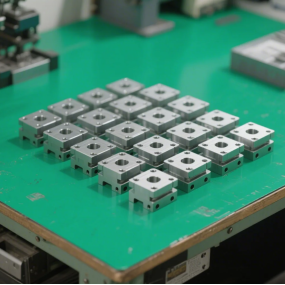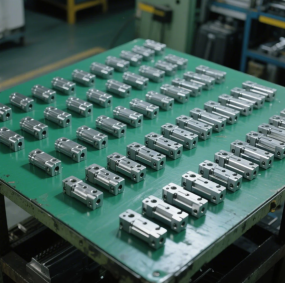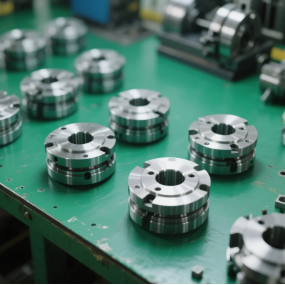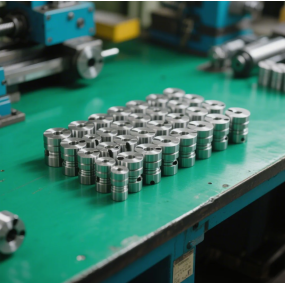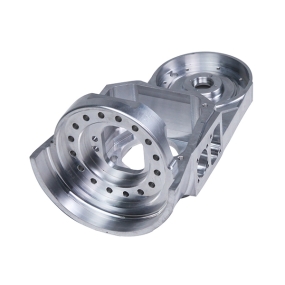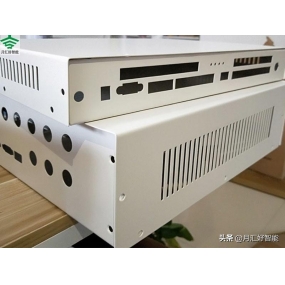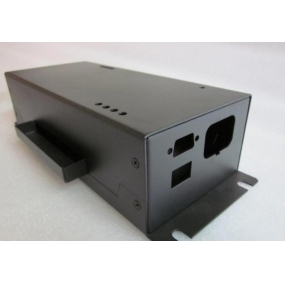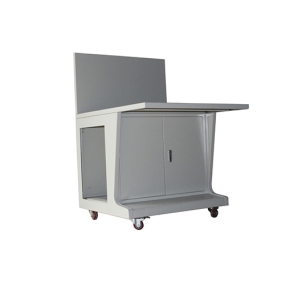The application of numerical control technology has brought qualitative changes to the traditional manufacturing industry, especially in recent years. The development of microelectronics technology and computer technology has brought new vitality to numerical control technology. Numerical control technology and numerical control equipment are important foundations for industrial modernization in various countries.
Numerical control machine tools are the mainstream equipment of modern manufacturing industry, the necessary equipment for precision machining, an important symbol of the technical level of modern machine tools and modern machinery manufacturing industry, and a strategic material related to the national economy and people‘s livelihood and the cutting-edge construction of national defense. Therefore, all industrialized countries in the world have taken major measures to develop their own numerical control technology and its industries.
CNC numerical control machining
CNC is the abbreviation of Computer Numberical Control in English, which means "computer data control", which is simply "numerical control processing".
Numerical control processing is an advanced processing technology in today‘s machinery manufacturing. It is an automated processing method with high efficiency, high precision and high flexibility. It is to input the numerical control program of the workpiece to the machine tool, and the machine tool automatically processes the workpiece that meets people‘s wishes under the control of these data to produce wonderful products.
Numerical control processing technology can effectively solve complex, precise and small batch changeable processing problems like molds, and fully adapt to the needs of modern production. Vigorously developing numerical control processing technology has become an important way for our country to accelerate economic development and improve independent innovation capabilities. At present, the use of numerical control machine tools in our country is more and more common, and being able to master numerical control machine programming is an important way to give full play to its functions.
Numerical control machine tool is a typical mechatronics product, it integrates microelectronics technology, computer technology, measurement technology, sensor technology, automatic control technology and artificial intelligence technology and other advanced technologies, and is closely combined with machining technology, is a new generation of mechanical manufacturing technology and equipment.
Composition of CNC numerical control machine
Numerical control machine is an automation equipment that integrates machine tools, computers, motors and technologies such as drag, dynamic control and detection. The basic components of numerical control machine tools include control medium, numerical control device, servo system, feedback device and machine tool body, as shown in Figure
1. Control medium
The control medium is the medium that stores all the action tool relative to the workpiece position information required for numerical control machining. It records the machining program of the part. Therefore, the control medium refers to the information carrier that transmits the machining information of the part to the numerical control device. There are many forms of control media, which vary with the type of numerical control device. The commonly used ones are perforated tape, perforated card, magnetic tape, magnetic disk, etc. With the development of numerical control technology, perforated tape and perforated card tend to be eliminated. The method of using CAD/CAM software to program in a computer and then communicate with the numerical control system to directly transmit the program and data to the numerical control device is more and more widely used.
2, numerical control device
The numerical control device is the core of the numerical control machine tool, which is referred to as the "central system". Modern numerical control machine tools use the computer numerical control device CNC. The numerical control device includes the input device, the Central Processor (CPU) and the output device, etc. The numerical control device can complete the information input, storage, transformation, interpolation operation and realize various control functions.
3. Servo system
The servo system is a driving part that receives the instructions of the numerical control device and drives the movement of the actuator of the machine tool. It includes the spindle drive unit, the feed drive unit, the spindle motor and the feed motor. When working, the servo system accepts the command information of the numerical control system, and compares it with the position and speed feedback signals according to the requirements of the command information, drives the moving parts or executive parts of the machine tool to operate, and processes the parts that meet the requirements of the drawings.
4. Feedback device
The feedback device is composed of measuring elements and corresponding circuits. Its function is to detect the speed and displacement and feed back the information to form a closed-loop control. Some numerical control machine tools with low accuracy requirements and no feedback device are called open-loop systems.
5. Machine tool body
The machine body is the entity of the numerical control machine tool, which is the mechanical part that completes the actual cutting processing, including the bed body, the base, the table, the bed saddle, the spindle, etc.
The characteristics of CNC Machining technology
The CNC numerical control machining process also follows the machining law, which is roughly the same as the machining process of ordinary machine tools. Because it is an automated machining that applies computer control technology to machining, it has the characteristics of high machining efficiency and high precision. The machining process has its own unique features. The process is more complicated and the work step arrangement is more detailed and meticulous.
CNC numerical control machining process includes the selection of tools, the determination of cutting parameters and the design of the cutting process route. CNC numerical control machining process is the foundation and core of numerical control programming. Only when the process is reasonable can a high-efficiency and high-quality numerical control program be compiled. The standards for measuring the quality of numerical control programs are: minimum machining time, minimum tool loss and the best workpiece.
The numerical control machining process is a part of the overall machining process of the workpiece, or even a process. It must cooperate with other front and rear processes to finally meet the assembly requirements of the overall machine or mold, so as to process qualified parts.
Numerical control processing procedures are generally divided into rough processing, medium and rough angle processing, semi-finishing and finishing steps.
CNC numerical control programming
Numerical control programming is the whole process from part drawing to numerical control machining program. Its main task is to calculate the cutter check point (cutter location point referred to as CL point) in machining. The cutter check point is generally taken as the intersection of the tool axis and the tool surface, and the tool axis vector is also given in multi-axis machining.
The numerical control machine tool is based on the requirements of the workpiece pattern and the machining process, and the movement amount, speed and action sequence, spindle speed, spindle rotation direction, cutter head clamping, cutter head loosening and cooling operations of the used tool and various components are compiled into a program sheet in the form of a specified numerical control code, which is input into the machine tool special computer. Then, after the numerical control system compiles, calculates and logically processes according to the input instructions, it outputs various signals and instructions, and controls each part to process various shapes of workpieces according to the specified displacement and sequential actions. Therefore, the programming has a great impact on the effectiveness of the numerical control machine tool.
The numerical control machine tool must input the instruction codes representing various functions into the numerical control device in the form of a program, and then the numerical control device performs calculation processing, and then sends out pulse signals to control the operation of the various moving parts of the numerical control machine tool, so as to complete the cutting of the parts.
There are currently two standards for numerical control programs: ISO of the international standards organization and EIA of the American Electronics Industry Association. ISO codes are used in our country.
With the advancement of technology, 3D numerical control programming is generally rarely manually programmed, and commercial CAD/CAM software is used.
CAD/CAM is the core of the computer-aided programming system, and its main functions include data input/output, machining track calculation and editing, process parameter setting, machining simulation, numerical control program post-processing and data management.
At present, in our country by users like, numerical control programming powerful software Mastercam, UG, Cimatron, PowerMILL, CAXA and so on. Each software for numerical control programming principles, graphics processing methods and processing methods are similar, but each has its own characteristics.
CNC numerical control steps of machining parts
1. Analyze the part drawings to understand the general situation of the workpiece (geometry, workpiece material, process requirements, etc.)
2. Determine the numerical control processing technology of the parts (processing content, processing route)
3, carry out the necessary numerical calculations (basis point, node coordinate calculation)
4. Write the program sheet (different machine tools will be different, follow the user manual)
5. Program verification (enter the program into the machine tool and perform graphical simulation to verify the correctness of the programming)
6. Machining the workpiece (good process control can save time and improve processing quality)
7. Workpiece acceptance and quality error analysis (the workpiece is inspected, and the qualified one flows into the next one. If it fails, the cause of the error and the correction method are found through quality analysis).
Development history of numerical control machine tools
After World War II, most of the production in the manufacturing industry relied on manual operation. After workers read the drawings, they manually operated machine tools and processed parts. This way, the production of products was expensive, inefficient, and the quality was not guaranteed.
In the late 1940s, an engineer in the United States, John Parsons, conceived a method of punching holes in a cardboard card to represent the geometry of the parts to be machined, and using a hard card to control the movement of the machine tool. At that time, this was just an idea.
In 1948, Parsons showed his idea to the US Air Force. After seeing it, the US Air Force expressed great interest, because the US Air Force was looking for an advanced processing method, hoping to solve the processing problem of aircraft shape models. Due to the complex shape of the model, high precision requirements, and difficulty in adapting to general equipment, the US Air Force immediately commissioned and sponsored the Massachusetts Institute of Technology (MIT) to conduct research and develop this cardboard-controlled machine tool. Finally, in 1952, MIT and Parsons cooperated and successfully developed the first demonstration machine. By 1960, the relatively simple and economical point-controlled drilling machine and the linear numerical control milling machine had been rapidly developed, which gradually promoted the numerical control machine in various sectors of the manufacturing industry.
The history of CNC machining has gone through more than half a century, and the NC numerical control system has also developed from the earliest analog signal circuit control to an extremely complex integrated machining system, and the programming method has also been manually developed into an intelligent and powerful CAD/CAM integrated system.
As far as our country is concerned, the development of numerical control technology is relatively slow. For most workshops in China, the equipment is relatively backward, and the technical level and concept of personnel are backward, which is manifested as low processing quality and processing efficiency, and often delays the delivery time.
The first generation of NC system was introduced in 1951, and its Control Unit was mainly composed of various valves and analog circuits. In 1952, the first CNC machine tool was born, and it has developed from a milling machine or a lathe to a machining center, becoming a key equipment in modern manufacturing.
The second-generation NC system was produced in 1959 and was mainly composed of individual transistors and other components.
In 1965, the third-generation NC system was introduced, which first adopted integrated circuit boards.
In fact, in 1964, the fourth-generation NC system was developed, namely the computer numerical control system (CNC control system) that we are very familiar with.
In 1975, the NC system adopted a powerful microprocessor, which was the fifth generation of the NC system.
6. The sixth-generation NC system adopts the current integrated manufacturing system (MIS) + DNC + flexible machining system (FMS).
Development trend of numerical control machine tools
1. High speed
With the rapid development of automobile, national defense, aviation, aerospace and other industries and the application of new materials such as aluminum alloys, the high-speed requirements for numerical control machine tool processing are getting higher and higher.
A. Spindle speed: The machine adopts an electric spindle (built-in spindle motor), and the maximum spindle speed is 200000r/min;
B. Feed rate: at a resolution of 0.01 µm, the maximum feed rate is 240 m/min and complex precision machining is possible.
C. Computing speed: The rapid development of microprocessors has provided a guarantee for the development of numerical control systems to high speed and high precision. The CPU has been developed to 32-bit and 64-bit numerical control systems, and the frequency has been increased to several hundred MHz and gigahertz. Due to the great improvement in computing speed, when the resolution is 0.1 µm and 0.01 µm, the feed speed can still be as high as 24~ 240m/min;
D. Tool change speed: At present, the tool exchange time of foreign advanced machining centers is generally around 1s, and the high has reached 0.5s. German Chiron company designs the tool magazine as a basket style, with the spindle as the axis, and the tools are arranged in a circle. The tool change time from knife to knife is only 0.9s.
2. High precision
The requirements of numerical control machine tool accuracy are now not limited to static geometric accuracy, and the movement accuracy, thermal deformation and vibration monitoring and compensation of machine tools are getting more and more attention.
A. Improve the control accuracy of the CNC system: using high-speed interpolation technology to achieve continuous feed with tiny program segments, making the CNC control unit refined, and using high-resolution position detection devices to improve position detection accuracy. The position servo system uses feedforward control and nonlinear control methods.
B. Adopt error compensation technology: using reverse clearance compensation, screw pitch error compensation, and tool error compensation to comprehensively compensate for the thermal deformation error and spatial error of the equipment.
C. Check and improve the movement track accuracy of the machining center by using grid technology: predict the machining accuracy of the machine tool through simulation to ensure the positioning accuracy and repeated positioning accuracy of the machine tool, so that its performance can be stable for a long time, and it can complete a variety of processing tasks under different operating conditions.
3. Functional integration
The meaning of composite machine tool refers to the realization or completion of various elements from rough to finished product on one machine tool. According to its structural characteristics, it can be divided into two categories: process composite type and process composite type. Machining centers can complete various processes such as turning, milling, drilling, hobbing, grinding, laser heat treatment, etc., and can complete all the processing of complex parts. With the continuous improvement of modern machining requirements, a large number of multi-axis linkage numerical control machine tools are more and more welcomed by large enterprises.
4. Intelligent control
With the development of artificial intelligence technology, in order to meet the development needs of manufacturing production flexibility and manufacturing automation, the intelligence of numerical control machine tools is constantly improving. Specifically reflected in the following aspects:
A. Process adaptive control technology;
B. Intelligent optimization and selection of processing parameters;
C. Intelligent fault self-diagnosis and self-repair technology;
D. Intelligent fault playback and fault simulation technology;
E. Intelligent AC servo drive device;
F. Intelligent 4M numerical control system: In the manufacturing process, the measurement, modeling, machining, and machine operation are integrated into one system.
5. Open system
Open to future technologies: Since both software and hardware interfaces adhere to accepted standard protocols, they can be adopted, absorbed, and compatible with a new generation of general-purpose software and hardware.
B. Open to users‘ specific requirements: update products, expand functions, and provide various combinations of hardware and software products to meet specific application requirements.
C. Establishment of numerical control standards: Standardized programming language, which is convenient for users, uses, and reduces labor consumption directly related to operation efficiency.
6. Drive parallel connection
It can realize multiple functions of multi-coordinate linkage numerical control processing, assembly and measurement, and can better meet the processing of complex special parts. Parallel machine tools are considered to be "the most meaningful progress in the machine tool industry since the invention of numerical control technology" and "a new generation of numerical control processing equipment in the 21st century".
7. Extreme (large and miniaturized)
The development of national defense, aviation, and aerospace industries and the large-scale development of basic industrial equipment such as energy require the support of large-scale and high-performance numerical control machine tools. Ultra-precision machining technology and micro-nano technology are strategic technologies in the 21st century, and new manufacturing processes and equipment that can adapt to micro-size and micro-nano machining accuracy need to be developed.
8. Networking of information exchange
It can not only realize the sharing of network resources, but also realize the remote monitoring, control, remote diagnosis and maintenance of numerical control machine tools.
9. Green processing
In recent years, machine tools that do not require or use less coolant to achieve energy conservation and environmental protection for dry cutting and semi-dry cutting have emerged, and the trend of green manufacturing has accelerated the development of various energy-saving and environmentally friendly machine tools.
10. Application of multimedia technology
Multimedia technology integrates computer, sound image and communication technology, making the computer have the ability to comprehensively process sound, text, image and video information. It can be integrated and intelligent in information processing, and is applied to real-time monitoring, fault diagnosis of systems and production field equipment, monitoring of production process parameters, etc., so it has great application value.


 Spanish
Spanish Arabic
Arabic Portuguese
Portuguese Belarusian
Belarusian Japanese
Japanese Russian
Russian Icelandic
Icelandic Bulgarian
Bulgarian Azerbaijani
Azerbaijani Estonian
Estonian Irish
Irish Polish
Polish Persian
Persian Boolean
Boolean Danish
Danish German
German French
French Filipino
Filipino Finnish
Finnish Korean
Korean Dutch
Dutch Galician
Galician Catalan
Catalan Czech
Czech Croatian
Croatian Latin
Latin Latvian
Latvian Romanian
Romanian Maltese
Maltese Malay
Malay Macedonian
Macedonian Norwegian
Norwegian Swedish
Swedish Serbian
Serbian Slovak
Slovak Slovenian
Slovenian Swahili
Swahili Thai
Thai Turkish
Turkish Welsh
Welsh Urdu
Urdu Ukrainian
Ukrainian Greek
Greek Hungarian
Hungarian Italian
Italian Yiddish
Yiddish Indonesian
Indonesian Vietnamese
Vietnamese Haitian Creole
Haitian Creole Spanish Basque
Spanish Basque

